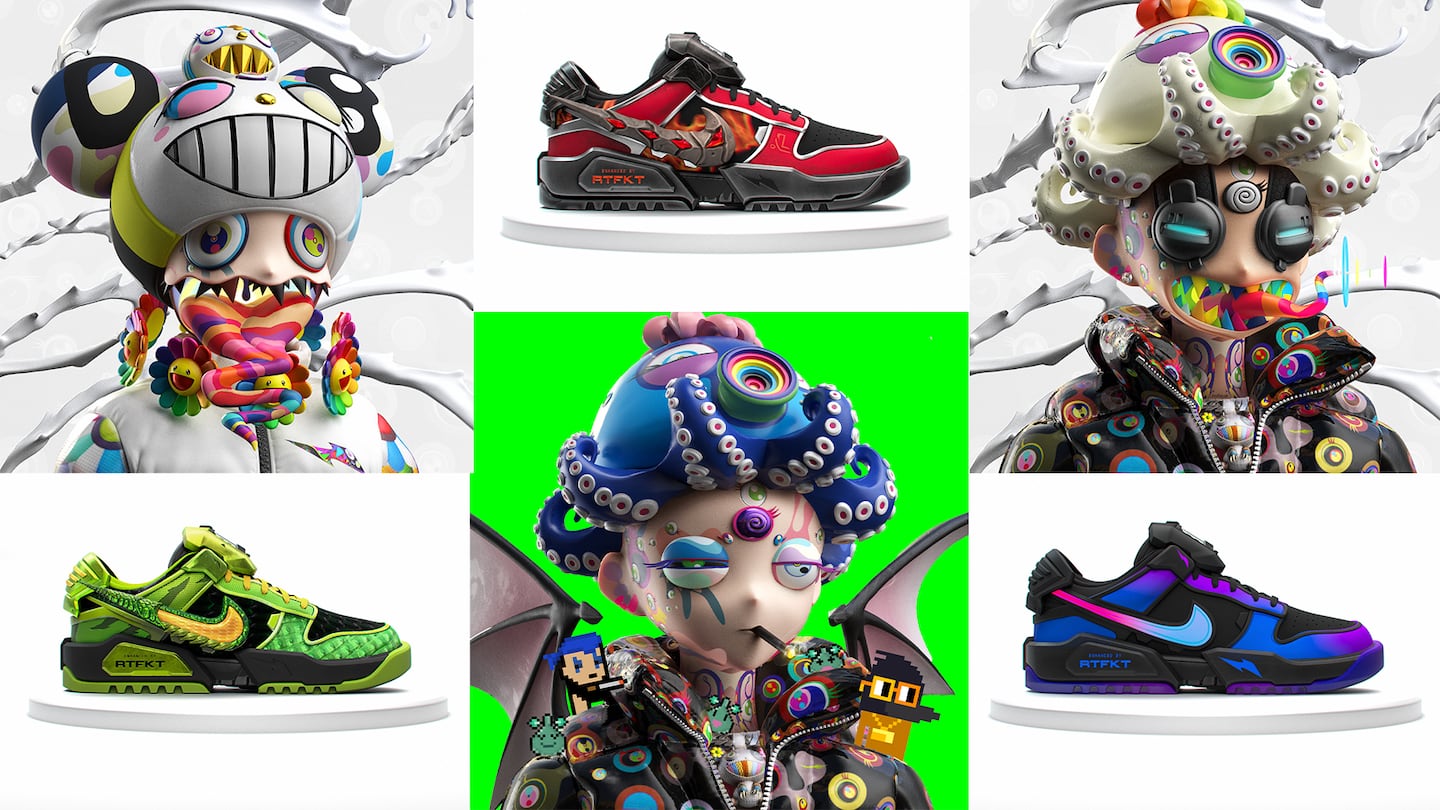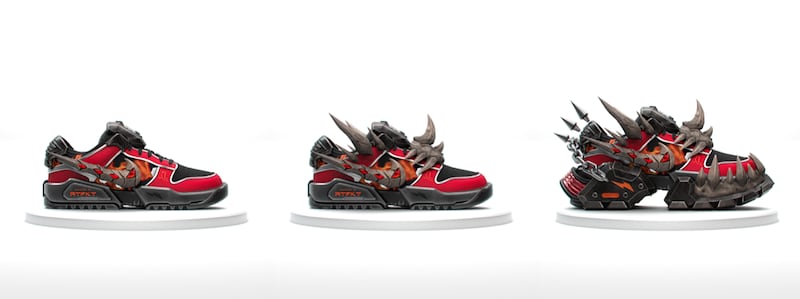
The Business of Fashion
Agenda-setting intelligence, analysis and advice for the global fashion community.

Agenda-setting intelligence, analysis and advice for the global fashion community.

In 2019, Benoit Pagotto, Chris Le and Steven Vasilev were on the verge of launching RTFKT — their brand of virtual sneakers riffing largely on classic Nike silhouettes — when they learned Nike itself had been granted a patent for blockchain-linked shoes it called CryptoKicks.
The trio, who were travelling in Japan to get inspired, questioned whether to keep going but ultimately carried on, beginning to drop digital shoes like the “Cybersneaker” famously photoshopped onto Elon Musk. Over the next year or so, RTFKT — pronounced like “artefact” — built its brand, blending streetwear and gaming through items like NFT sneakers and collaborations.
During that period, Nike never released its CryptoKicks. Instead, it acquired RTFKT in December. When the sneaker giant did put out its first NFT footwear, the Nike Dunk Genesis CryptoKicks, it was with RTFKT, whose founders are now senior directors at the company.
In the time between the Japan trip and the launch of the Nike CryptoKicks, RTFKT became one of the biggest brands in the NFT market, which surged to $17.7 billion in sales in 2021, according to data from Nonfungible. Collectors have snatched up items like its sneakers with digital artist Fewocious and the “CloneX” avatars it created with Takashi Murakami for sums that routinely reach into the thousands or tens of thousands of dollars — and sometimes higher.
ADVERTISEMENT
To those Clone owners, who form the foundation of the ecosystem it is building, it has “airdropped” freebies they can use with their Clones to start assembling a fictional world. What the company is really trying to do is construct the metaverse, step by step, by encouraging its audience to use its products as the building blocks.
The brand’s fans on Twitter and Discord anxiously await news of what’s to come. This year, they spent months eagerly solving puzzles trickled out by RTFKT to unlock one of those airdropped items, a mysterious cube RTFKT dubbed MNLTH. (The opening revealed RTFKT’s CryptoKicks with Nike, a “skin vial” to customise them and another MNLTH.)
“These buzzwords that we hear in retail and fashion and consumer culture of authenticity, experience and community, they live at the cross-section of them,” said Brian Trunzo, a fashion industry veteran who is now metaverse lead at Polygon Studios, the consulting arm of the Polygon blockchain.

It arguably makes RTFKT a new kind of brand — one poised somewhere between the currents of fashion, crypto and gaming, and well-positioned to capitalise on the growing confluence of the three.
But it also has to contend with the challenges of the NFT market. Overall sales have slowed, and the market is rife with financial speculation. Many NFT projects appear to be cash grabs without much evident thought beyond a quick profit, tarnishing the image of the space. Not least of all, the space itself is entirely new, making its future far from clear.
RTFKT’s Vision for the Future
RTFKT’s founders met in 2018, when Pagotto, then head of marketing for the e-sports team Fnatic, was searching for someone to make gaming skins — add-ons that change the appearance of a character or item. He found Le, who had a business creating skins for “Counter-Strike.” Their paths then crossed with Vasilev, who ran a successful sneaker customisation studio in London, and together they produced a shoe for Fnatics’ “League of Legends” team.
If there’s one belief that unites them and drives RTFKT, it’s that the digital signifiers we use to broadcast our identities, tastes, social status and other traits are just as important as the physical ones — if not more so.
ADVERTISEMENT
“The vision has always been that in the future all your digital possessions will be a lot more valuable to you than your physical possessions, and that means both economically and emotionally,” Pagotto said.
Virtual goods still have a long way to go before they surpass real-world stuff on a mainstream level — if that ever happens. But what’s clear is consumers who are online are spending more time there. RTFKT is designing for this future, devising identities, digital products and even homes. It sent “space pods” to the wallets of Clone holders that look like small futuristic apartments.
The point is to make all releases going forward interoperable, meaning they can be worn by a Clone, displayed in the space pod or used in some other way with previous RTFKT items. Vasilev said the next phase they’re moving into is “building full ecosystems and different units where everything will interlink.”
In doing so, RTFKT allows its fans to combine its products in different ways, involving them in building its mini-universe. Items like the Nike CryptoKicks are also AR-enabled, so parts of that universe can be overlaid on the real world.
The team is now introducing “evolution” mechanics. Owners of the CryptoKicks can use the “skin vials” RTFKT is releasing to change their look, which is derived from gaming aesthetics. But using a skin vial “burns” it, so as more are used the rarity of certain vials will increase.

Building With Nike
How, exactly, this vision sits within Nike’s business isn’t fully apparent, at least not yet. Pagotto described Nike and RTFKT as both being innovators, just in different worlds: Nike in sports, RTFKT in web3. While he was initially surprised Nike wanted to buy their company, he ultimately concluded it made sense. If Nike planned to enter this space, the smart approach, in Pagotto’s view, was to bring on a team that could build in it natively.
But while the RTFKT team advises Nike, it isn’t crafting the company’s NFT strategy, according to Pagotto. Its day-to-day focus is still RTFKT, over which it maintains autonomy. The companies do work closely though. Nike has an interest in protecting the legacies of products like the Dunk, a style that was instrumental in the birth of modern sneaker culture, and just the first of Nike’s classic styles RTFKT said it will modify.
ADVERTISEMENT
“Especially with the art, we get a lot of insight from Nike’s team on keeping the traditional, classic look,” Le said. “As RTFKT, we tend to go a little crazy.”
RTFKT, meanwhile, gets to tap into Nike’s archive, draw on its brand-building expertise and get access to the machinery behind the largest sneaker company in the world. RTFKT was already a pioneer in what’s called “forging,” where an NFT product is turned into a tangible one.
“We’ve had nearly every resource opened to us and we have some really cool physical products coming out of the pipeline,” Vasilev said.
Their goal is to gradually bridge the digital and physical worlds.
Fighting “FUD” and the Road Ahead for NFTs
After soaring in 2021, the market for NFTs has recently cooled. Both the number of NFT sales and average prices have fallen, and sceptical analysts have raised doubts about its long-term outlook.
The crypto community generally retorts that NFTs are in their early stages, and their full uses still being worked out. They’ll evolve far beyond the jpeg collectables that have dominated the space, the argument goes.
“The trend is moving towards giving them utility, so that they can be used within metaversal virtual worlds or to unlock next-gen loyalty rewards from desirable brands,” Polygon’s Trunzo said. “If they don’t have utility — if they are just collectables — they will become akin to the stuff that you find in your junk drawer.”
RTFKT subscribes to this view, but it isn’t entirely insulated from what those in crypto call “FUD” — fear, uncertainty, doubt. When it first revealed its CryptoKicks with Nike, after months of making its fans solve riddles to unlock the MNLTH containing them, some posters in its Discord were not immediately impressed. The price of a MNLTH on the secondary market abruptly dropped.
It rebounded within minutes, though, as more detail about its contents and the CryptoKicks emerged. (Vasilev also pointed out that they gave out the MNLTH for free, so the fact that they were being traded for any substantial value was a testament to their success.)

“What we know for sure as a rule is there will always be people who complain,” Pagotto said. “There will always be people who try to take advantage of the situation.”
These are common issues in web3. Because creative projects double as financial assets, frequently with high price tags, they’re often measured by how much profit they might generate for those who buy in. The space is also brimming with scams.
The RTFKT team acknowledged these as challenges, and added that the user experience in web3 is complicated and cumbersome at this stage. But they and others in crypto see these as the normal problems that come with entering a new technological frontier.
For now, RTFKT’s interest lies in continuing to work on projects they believe in, with Nike and on their own. Maybe most important is gathering the help they need to fulfil their vision.
“You need to be able to build worlds,” Pagotto said, “and also mainly attract a community that’s going to build that world with you.”
Benoit Pagotto joins BoF founder and editor-in-chief Imran Amed at the BoF Professional Summit: New Frontiers in Fashion and Technology to share tangible opportunities for fashion within the metaverse. The event will be available to livestream globally for BoF Professional All-Access members. Register for the livestream today.
Brands like Adidas, Gucci and The Hundreds are finding the tokens are a great way to reward their superfans. But maintaining that loyalty can be hard work.
Their mix of technical expertise and digital artistry has put 3D creators, game designers and NFT experts in high demand among fashion brands as they venture further into virtual territories.
Brands such as Tommy Hilfiger and Dolce & Gabbana were among those to test the virtual waters, encountering challenges like low-quality visuals as well as some opportunities.

Marc Bain is Technology Correspondent at The Business of Fashion. He is based in New York and drives BoF’s coverage of technology and innovation, from start-ups to Big Tech.
Successful social media acquisitions require keeping both talent and technology in place. Neither is likely to happen in a deal for the Chinese app, writes Dave Lee.
TikTok’s first time sponsoring the glitzy event comes just as the US effectively deemed the company a national security threat under its current ownership, raising complications for Condé Nast and the gala’s other organisers.
BoF Careers provides essential sector insights for fashion's technology and e-commerce professionals this month, to help you decode fashion’s commercial and creative landscape.
The algorithms TikTok relies on for its operations are deemed core to ByteDance overall operations, which would make a sale of the app with algorithms highly unlikely.